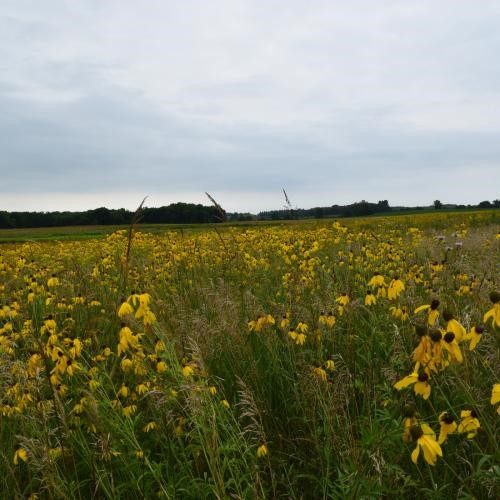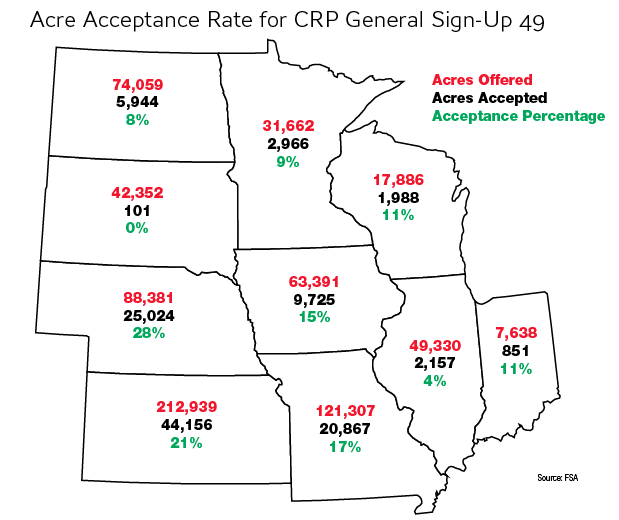By Anna McConnell, Successful Farming
At the end of September, contracts for nearly 1.7 million acres of land enrolled in the CRP will expire. Getting land into the CRP is more competitive than ever with low commodity prices and fewer CRP acres available because of the 2014 Farm Bill CRP reduction of 8 million acres.
Of the expiring acres, 211,000 were accepted into the program again through CRP General Sign-Up 49, but the 500,000 expiring continuous acres will have to wait until October 1 to see what’s available. Around 900,000 of the expiring acres were rejected from reentering the CRP because the land no longer had a high enough environmental benefit index (EBI) score.
This year’s qualifying EBI score was 292, which is much higher than the 2013 qualifying EBI score that was closer to 220. Only 411,000 acres of the more than 1.85 million acres offered were accepted in CRP General Sign-Up 49 that ended in March. The state of South Dakota’s CRP acceptance rate was only .02%.
Val Dolcini, FSA administrator, has seen interest in continuous practices grow over the past five to six years. Programs that are geared toward a specific cause, like the State Acres for Wildlife Enhancement (SAFE) program and the wetlands initiatives, are becoming more popular among producers and landowners. Targeted acres have doubled in the past 10 years, according to the FSA.
“I think over the last three to five years, you’ve seen landowners more sensitive to the pollinator piece, the habitat piece, and the specific food source piece,” says Kirk Weih of Hertz Farm Management in Mount Vernon, Iowa.
In 2007, there were 36.7 million acres in the CRP with only 3 million of those in the continuous program. Today, there are only 24 million CRP acres, and nearly 7 million of those are continuous program acres.
Landowners Looking to CRP
With cash rents declining, it isn’t a huge surprise that landowners are scrounging to stay profitable. One of the ways they are doing that is by trying to get land, even whole farms, into the CRP.
“It makes financial sense for some landowners to do that in light of lower grain prices and forecasts for cash rental rates to continue to decline,” says Randy Dickhut, Farmers National Company senior vice president.
Weih estimates that roughly 5% to 10% of the landowners he’s in touch with are considering enrolling in CRP or have done so.
Jason Tronbak, Millborn Seeds conservation specialist in Brookings, South Dakota, saw a spike in interest in the CRP when the program’s rental rates were raised in 2016. With commodity prices in a slump, interest was already high, but it was the perfect storm for throwing land into the profitable CRP.
“Landowners are willing to sign up everything they have if that’s more than what they can make in cash rent,” says Jason Tronbak.
“Iowa has the biggest increase of demand, but there’s definitely been an increase in demand in every state,” says Tronbak. “For us, it has been a pretty significant increase in interest and purchases.”
Jon Peterson, a Farmers National Company real estate agent, can think of several Iowa landowners who have enrolled big tracks of ground in continuous CRP rather than renting to farmers this year.
“Some of the continuous CRP rates offer $25 to $75 more than what the cash rent rate would be this year,” says Peterson, who recently enrolled 100 acres of his own Iowa farmland in CRP that was previously cash-rented ground. Peterson says landowners can make more on continuous CRP payments than cash rent on most lesser-quality farmland.
“Farmers who actually own the land are putting really marginal amounts in CRP, but the landowners are willing to sign up everything they have if that’s more than they can make in cash rent,” says Tronbak.
A southern Minnesota farm manager has clients who are profiting more from buffer strip payments than they are from cash rents. However, he and his colleagues don’t encourage clients to put whole farms in the CRP.
Farmers Looking for Higher Returns
Jamie Diebal, Illinois FSA program specialist, has seen a lot of producers putting land into the CRP and not farming it. Although Illinois had an alarmingly low acreage acceptance rate during the CRP General Sign-Up 49, Diebal saw more offers than she’d seen in Illinois in the past.
“With CRP, farmers are guaranteed a rate for the life of their contract, which could be 10 to 15 years,” says Diebal. “It’s appealing for some producers to do that.”
There are 40 to 45 Conservation Reserve Enhancement Programs (CREP) in the U.S.
According to Dolcini, the Conservation Reserve Enhancement Program (CREP), which is considered part of the continuous CRP, has also become quite popular over the years. CREP initiatives are partly funded by individual states and also by the federal government (there are currently 40 to 45 nationwide). Driven by local interest, CREP proposals are currently being prepared with states like Nebraska and Minnesota.
Diebal is hopeful that the one CREP opportunity in Illinois will be funded by the state’s budget again in November or December, because the program has not accepted any new acres since August 2015 due to a lack of state funding. The program can only accept 250,000 acres and has over 200,000 currently enrolled.
“Over the years, the CRP has shown to be an effective way of providing an economic safety net for farmers and also a good way to preserve America’s landscape,” says Dolcini.
This year, 101,000 acres were accepted into the grasslands CRP initiative. The program pays less in rent, but it benefits livestock producers who can use sections of the land at certain times to graze livestock and to cut feeding costs.
Lots of Interest, High Demand for Seed Mixes
An increased interest in the CRP has left the companies offering specialty seed mixes scrambling at times, according to Tronbak.
In the spring, the demand for the specific grasses and flowers some state programs require went up so quickly that a widespread shortage was experienced. Prices went up swiftly for seed used in specialty CRP plots.
However, farmer and landowner interest in the CRP is known to cycle with economic factors. When commodity prices were high in 2012, the FSA saw farmers looking to pull acres out of the program to make more money farming the land. When some saw the penalty cost, though, they reconsidered and ended up sticking with the program. According to the FSA, it is quite rare when a landowner or producer pulls acres out.
The FSA is under pressure to dedicate more acres to the continuous program, but the incoming secretary of agriculture will likely be the one deciding to have another general sign-up or to bump up continuous acres in 2017. Until then, the FSA will stay choosy with the few CRP acres it has left to allot.








